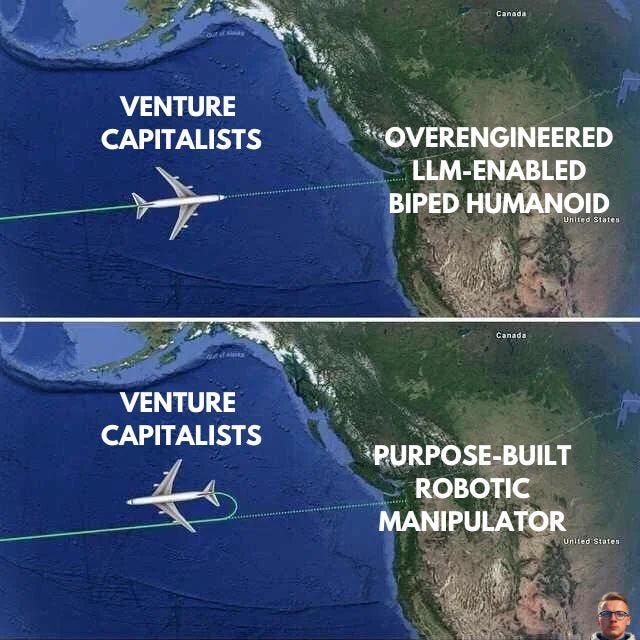EP.48 A ROBOT HELPING THE POLICE
BYD starts developing humanoids, a new patrolling robot, Intel spins off RealSense cameras business & much more...
A spherical patrol robot for police 🚔
China is testing a futuristic crime-fighting robot, the Rotunbot, in police patrols. This 125-kg (276-lb) self-balancing robotic sphere can reach speeds of 35 km/h (22 mph) on land or water and is equipped with non-lethal weapons like tear gas, smoke bombs, and net shooters.
The Rotunbot uses gyroscopic self-stabilization to move quietly and smoothly, even on uneven terrain like mud, slush, or shallow water. It’s waterproof and buoyant, enabling it to roll into rivers and back out without issue. With GPS, cameras, and ultrasonic sensors, it tracks targets and navigates obstacles while avoiding collisions with people.
Currently deployed in Wenzhou, Zhejiang province, for police trials, the Rotunbot is remotely controlled, but future versions may include autonomous features. While it’s not perfect—its wobbly turns and limited stair navigation are noted drawbacks—it offers promise in non-lethal takedowns and pursuit, filling a niche in police robotics.
ABB Robotics revolutionizes the automotive sector in India! 🚗
Robotics is transforming industries across India, particularly in the automotive sector, driven by advancements in artificial intelligence, generative AI, and automation technologies. Sami Atiya, president of robotics and discrete automation at ABB, highlighted how these innovations are enabling robots to handle complex and unpredictable tasks, from sorting parcels in logistics centers to performing precision work in electronics and laboratories.
ABB robots have already painted 65% of cars manufactured in India and play a critical role in electric scooter maker Ola Electric’s mega-factory.
AI-enhanced robotics is also breaking new ground. ABB has piloted systems where robots respond to natural language commands like “Pick the red box and place it on the blue one.” This capability, powered by generative AI, is reshaping how robots interact with their environments.
Beyond factories, ABB’s solutions like Visual SLAM Navigation and Robotic ItemPicker bring automation to warehouses, optimizing tasks with unmatched precision and efficiency. Investments in startups like Sevensense have enhanced ABB’s autonomous mobile robot navigation, eliminating the need for fixed routes and allowing real-time mapping.
Dr. Sami Atiya joined a panel discussion hosted by the Swedish Chamber of Commerce India where industry leaders explored AI's transformative potential.
Watch this video to know more:
🦾 Feature sponsorship with ABB Robotics
Chinese Tesla has started building humanoids! 🥢
BYD has officially announced its entry into humanoid robotics, launching a global recruitment drive for its Embodied Intelligence Research Team. The campaign seeks top graduates from the class of 2025, offering positions such as Senior Algorithm Engineers and Senior Structural Engineers to drive advancements in humanoid and bipedal robotics.
The Embodied Intelligence Research Team leverages BYD’s vast industrial experience to develop cutting-edge robotic systems. With a focus on robotic perception and decision-making, the team has already created industrial, collaborative, mobile, and humanoid robots, aiming to accelerate embodied intelligence adoption in the industry.
This initiative aligns with BYD’s AI strategy. During its recent 30th-anniversary celebration, the company committed 100 billion yuan ($13.73 billion) to AI innovations, including upgrading vehicle intelligence. BYD’s collaboration with Ubtech Robotics has already integrated humanoid robots like the Walker S1 into its factories, performing tasks like inspections and quality checks alongside autonomous logistics systems.
Intel spins off RealSense as independent company 📸
Intel has announced that it will spin off its RealSense depth camera business into a standalone company by the first half of 2025. The new entity will be an Intel Capital portfolio company, maintaining its product roadmap and continuing to develop AI-powered computer vision solutions.
RealSense, known for its depth cameras and applications in robotics and biometrics, has long been a small but innovative part of Intel’s operations. The move, Intel said, aligns with its strategy to focus on core businesses while giving RealSense the flexibility to scale independently in competitive markets.
The RealSense portfolio will remain intact, including its depth cameras, facial authentication solutions, and tools for autonomous robots. Intel assured customers of uninterrupted support and plans to expand into new stereo vision and robotics AI innovations under the new company.
RealSense products have been widely adopted in robotics, including ANYbotics’ quadruped ANYmal, which uses RealSense modules to navigate complex terrain. The spinout marks a new chapter for RealSense, offering both opportunities for growth and challenges as it moves forward without Intel’s extensive resources.
Everye roboticist know these cameras very well.
Meme of the week 🤖
To humanoid or not to humanoid, that is the question.
Build and program your own drone [WEBINAR] 📺
Using Simulink, you will learn how to develop and deploy code for UAVs, including Raspberry Pis and Jetson GPUs, using Pixhawk Flight Controllers. During this session, you will also learn how to integrate and test these systems, so that you can compete in student aerospace competitions with confidence.
Key Topics:
Code generation and deployment on Pixhawk Flight Controllers.
CUDA code generation and deployment for Jetson GPUs as a Flight Computer.
Integration and testing of Flight Controller and Flight Computer codes in a given scenario.
Serve Robotics secures $86M to expand business 🚚
Serve Robotics has raised $86 million in new funding, bringing its total capital raised in 2024 to $167 million. With this boost, the Redwood City-based autonomous delivery company has financial stability through the end of 2026.
Serve Robotics, a 2021 spinoff from Uber, develops AI-powered, low-emissions robots for sidewalk delivery. The company has completed thousands of deliveries for partners like Uber Eats and 7-Eleven. Serve has contracts to deploy up to 2,000 robots on the Uber Eats platform and is testing drone integration through a partnership with Alphabet’s Wing Aviation.
The company plans to ramp up production of its third-generation robots, which offer improved speed, range, and capacity. Using NVIDIA’s Jetson Orin module and Ouster’s REV7 digital lidar, the robots navigate autonomously and hold 15% more cargo than earlier models.









